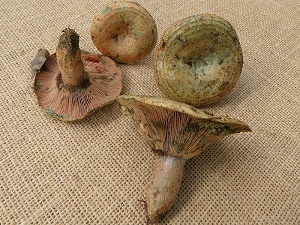| Lactarius sanguifluus (Paulet) Fr. |
|
|
|
|
|
|
The cap is orange spotted with green. The cap surface is with faint concentric bands, not viscid nor sticky. The stem is orange, without ring. The flesh is white, turning red when exposed to air; its taste is mild; the odour is not distinctive; its texture is grainy (breaking like a chalk stick), exuding when cut a blood-red milk turning brown without green when exposed to air. The gills are vinaceous red to green, adnate to decurrent, crowded . The spore print is white. This species is mycorrhizal. It grows in mixed or coniferous woods, on a rather calcareous soil, with Aleppo pine, stone pine. The fruiting period takes place from July to December.
Distinctive features : orange-brown cap, more or less with green patches; milk turning red immediately when cut; stem with vinaceous red blotches; under pine exclusively, mostly Mediterranean Lactarius sanguifluus is still unreported so far in the forest of Rambouillet, and is infrequent, more generally speaking .
page updated on 14/01/18 |
